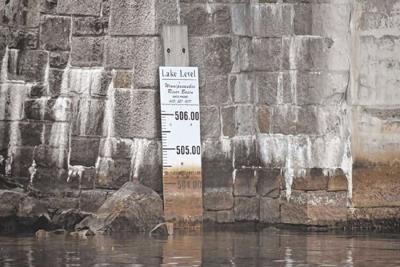Fall has arrived here on Lake Winnipesaukee. The air is crisp and the leaves are colorful heading into this holiday weekend. All around the lake, locals and visitors alike are enjoying all the wonderful fall activities that the area has to offer, from the Sandwich Fair to corn mazes.
While everyone is out appreciating the changing of the seasons, Lake Winnipesaukee along with many other lakes throughout New Hampshire will begin experiencing a change, as well. Back in September, the New Hampshire Department of Environmental Services announced the dates of the state's fall drawdown of the lakes, most of which occur toward the end of Columbus Day weekend. I have always been aware that the lakes and ponds controlled by dams across New Hampshire were drawn down annually, but never thought to ask why until this year. I’d like to share with you what I’ve learned so we can all better understand what happens to our lakes and why lake levels are lowered as we head into the winter season.
Why do we draw down the lakes? Lake drawdowns are performed annually during the fall as an effort to reduce winter ice damage to shoreline properties and to reduce spring flooding. Lowering the lake levels also provides opportunities for towns and homeowners to perform maintenance or address any repairs to waterfront structures or properties. There are some other benefits to lake drawdowns, such as aquatic plant control. Lake level drawdowns and the resulting exposure of sediments to prolonged freezing and/or drying is an inexpensive way to help control the density of aquatic plants. Drawdowns may stress plants; the low water levels can result in plants drying out, subsequently affecting their ability to transport nutrients and to function. Additionally, plants may also be physically removed from their habitat as a result of ice scouring. Together, these effects of drawdown may temporarily reduce plant density for a period of time.
The length of drawdown of a lake or pond depends on snow and ice cover, water uses and expected water renewal rates. Drawdown is also not an overnight event, it happens gradually. The lake levels are brought down slowly in order for aquatic fauna, such as mollusks and amphibians, to adapt to the changing water level. October into November is the typical time for lake drawdowns; the degree and date of the start of drawdown for each lake varies since the hydrologic conditions and recreational uses of each waterbody varies. Additionally, the amount of rainfall during that period and operational constraints can cause the drawdown start date to vary.
Many lakes across the state will begin to be drawn down toward the end of this holiday weekend, including Opechee, Squam, and Winnisquam. The depth of drawdown varies by lake and is determined not from the current lake level, but from the normal full lake/pond level. Some lakes experience several inches of drawdown while others like Glen Lake in Goffstown experience 30 feet. For our lakes here in the Lakes Region, drawdown is on average around 2-3 feet with Opechee experiencing the most drawdown of 5 feet.
Lake Winnipesaukee is a special case when it comes to the annual statewide fall drawdown. Winnipesaukee is not purposely drawn down but instead after Columbus Day, releases from the Lakeport Dam are reduced. The average output of the Lakeport Dam is 250 cubic feet per second (cfs) but after Oct. 10, this will be reduced to a flow between 30 and 50 cfs for a period of up to two weeks. This rate of flow is chosen because 30 to 50 cfs is the minimum flow needed to maintain aquatic life downstream. The reduction will allow for maintenance to be conducted on the dams and hydropower facilities on the Winnipesaukee River.
By the middle of the fall, Lake Winnipesaukee is approximately 15 inches below its springtime full level on average. As a result of the reduction in the amount of water released from the Lakeport Dam after Columbus Day, the lake level does not drop for the remainder of October and is maintained at this level through December. Maintaining a stable lake level is important for aquatic species that call Lake Winnipesaukee home. For example, the lake trout in Winnipesaukee spawn right around Halloween each year. Thus, it’s important that the lake level does not fall much below the level it is at on Halloween to avoid stranding the eggs.
Just like the cycle of the seasons with leaves returning in the spring, lake levels will be brought back up before the summer season. It’s important that the lake levels are returned to normal before summer for many reasons, including recreational and aesthetic purposes. It’s also important ecologically, for the aquatic species and for keeping terrestrial species from encroaching on the lake bed. If you’d like to learn more about fall drawdown and the drawdown depths that the New Hampshire lakes will experience, check out NH DES’s article at www.des.nh.gov/news-and-media/state-announces-its-2022-fall-drawdown-lakes.
•••
Jacquelyn Bellefontaine is the conservation outreach manager for the Lake Winnipesaukee Association. She manages communications and outreach initiatives. Jackie can be reached at jbellefontaine@winnipesaukee.org.
The Lake Winnipesaukee Association is a nonprofit dedicated to protecting the water quality and natural resources of the lake and its watershed. To learn more, visit winnipesaukee.org.


















(0) comments
Welcome to the discussion.
Log In
Keep it Clean. Please avoid obscene, vulgar, lewd, racist or sexually-oriented language.
PLEASE TURN OFF YOUR CAPS LOCK.
Don't Threaten. Threats of harming another person will not be tolerated.
Be Truthful. Don't knowingly lie about anyone or anything.
Be Nice. No racism, sexism or any sort of -ism that is degrading to another person.
Be Proactive. Use the 'Report' link on each comment to let us know of abusive posts.
Share with Us. We'd love to hear eyewitness accounts, the history behind an article.